When one marketing channel is performing well, it’s common for eCommerce brands to devote as much budget as possible to that top-performer — more often than not, at the expense of other, less-flashy initiatives and efforts.
But, in our experience, the best results come from a more integrated approach.
And today’s case study is the living proof.
Gone are the days of devoting all of your budget and attention to a single marketing platform. To succeed in today’s varied eCommerce market, you need a strategy that incorporates several advertising channels, working in tandem for full-funnel success.
Today, we’ll walk you through how that approach drove record-breaking revenue for our client Tactipup, including the company’s best sales month ever in November 2021.
The video below is hosted on YouTube. If you need assistance with viewing the video, please contact info@goinflow.com.

Drive similar results for your pet product brand by connecting with our digital marketing experts for a free audit and strategy proposal. Get started now.
Client Background
Tactipup is an eCommerce brand that’s experienced explosive growth in the past few years, thanks in large part to compelling social media branding. As a seller of over-built dog gear (including collars, harnesses, leashes, and more), the company’s social media presence is tough to beat.
After all, who doesn’t want an adorable personalized collar after seeing an image like this?
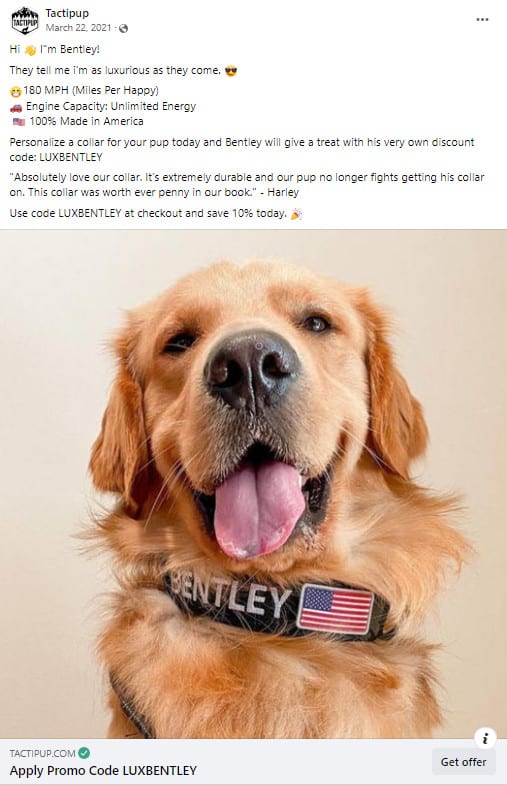
But, as popular as Tactipup’s social media posts are, continuing to scale its sales growth (and managing its expanding ad accounts) in-house was limiting the brand’s results. Add in a Google Ads account that was chronically underperforming, and Tactipup knew it was time to look for a digital marketing agency to take their campaigns to the next level.
So, in early 2021, they partnered with Inflow to place their paid and social efforts into more experienced hands.
Just a few months later, Tactipup’s well-performing paid social efforts were turned upside down with the launch of iOS 14.5 and its subsequent effects on Facebook and Instagram advertising. To keep Tactipup growing at the pace it desired, our team needed to come up with a multi-channel solution — and fast.
Here’s what we did:
Creating iOS-Proof Paid Social Strategies
Because of the immediate effects of iOS 14.5, we devoted increased attention to bringing back Tactipup’s paid social success.
Our goal: Identify Facebook’s new inefficiencies and discover much-needed solutions for our client.
As a reminder, iOS 14.5 was most felt by social media marketers in terms of purchase attribution. Before this update, purchases from individual campaigns could be attributed up to 28 days after a customer action (click, engagement, website visit, etc.). At the time we took over Tactipup’s accounts, that window had dropped to 7 days.
Combine that with fewer customers opting into third-party tracking, and the strategies that used to drive big results for Tactipup were no longer effective.
So, we set out to identify the new strategies that would.
1. Finding New Audiences in a Shrinking Pool
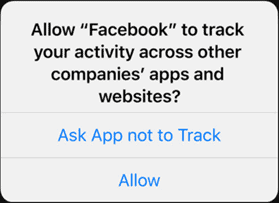
Due to the privacy update, Tactipup’s current lookalike audiences were no longer driving the success they used to.
Social media audiences were shrinking as customers declined third-party app tracking. The customer segments Tactipup had previously relied on were no longer accurate, and we needed to find opportunities to expand those audiences, bringing in new customers to make up for those our client had lost.
We did this in a few ways:
Stacking, Not Segmenting
Prior of iOS 14, our eCommerce clients saw the best results from tailored audience segmentation. With such a vast number of users to target, we used lookalike audiences to identify super-charged performers — and then replicated that as much as we could. (It’s how we helped Vitrazza hit their first $1 million sales month, too.)
But, with newly limited audiences, these specialized targets would eventually ran out of steam.
By stacking groups of audiences (instead of segmenting), we could combine well-performing groups and give Facebook’s machine learning algorithm more details to pull from. The more potential customer demographics we could provide, the more audiences Facebook’s AI had the leverage to find — and the more opportunities it had to match the perfect ad with each customer.
It worked just as planned.
When comparing the performance of an 8% segmented lookalike with an 8% stacked lookalike, the results were clear. While the segmented lookalike only generated 2.4x ROAS, the stacked lookalike generated 3x ROAS — a 25% increase.
Moving Up in the Sales Funnel

Previous Tactipup campaigns had narrowed in on the audiences most likely to purchase: those at the bottom of the funnel. But, to avoid fatiguing those now-smaller audiences, we needed to expand our initial target audience.
For Tactipup, that meant incorporating “add to cart” customers.
We started with Instagram, where photos and videos of dogs are (dare we say it) even more popular than on Facebook. By opening up Tactipup’s target audience to include more customers, we could tap into a larger market for their products.
The goal here wasn’t necessarily to get customers to buy. Instead, our campaign strategy was getting users to click into Tactipup’s main site, browsing products and (hopefully) adding them to cart for later.
Even though purchase wasn’t our goal with these campaigns, their addition fueled the fire on our existing purchase campaigns. Not only did we see Instagram referral traffic increase, we also saw improvements in our bottom-funnel and purchase campaigns at the same time — for an overall 39% increase in add-to-cart events, 73% increase in purchases, and 15% increase in ROAS.
Moral of the story? You may need to spend more on non-purchase-related campaigns to find the audiences needed to increase your sales. If you do it right, your investment will pay for itself.
Need help creating those audience growth campaigns? Contact our paid social experts anytime.
2. Consolidating Existing Ad Sets & Campaigns
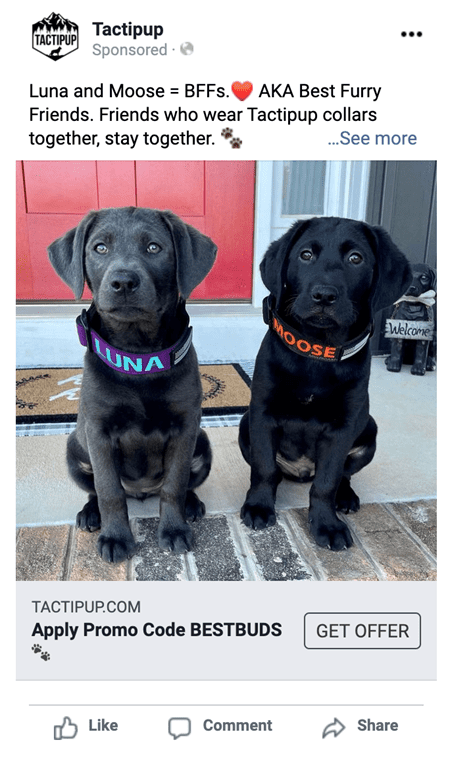
That’s not to say you have to spend outrageous amounts of money to find success with social media advertising. If you’re allocating your spend correctly, you can still see growth on a humbler budget, especially in today’s paid social climate.
Before iOS 14.5, we’d been running several niche ad sets as part of our segmentation — for example, one ad set targeting Facebook engagers, one targeting Instagram engagers, and one targeting website engagers.
But, as those audiences shrank, those ad sets failed to emerge from Facebook’s learning limited stage. There simply wasn’t enough audience information to feed the algorithm and generate substantial growth.
So, to give Facebook the information it needed, we consolidated those ad sets into one. In doing so, we combined those separate budgets, giving Facebook’s algorithm more room to explore and identify new audiences.
The result: Wider audience targeting, resulting in more overall events (including a 190% increase in purchases) from that consolidated ad set.
3. Putting the Trust Back in Facebook
For a business that had historically relied on solid paid social campaigns to drive revenue, the loss in attributed sales after iOS 14.5 was initially shocking.
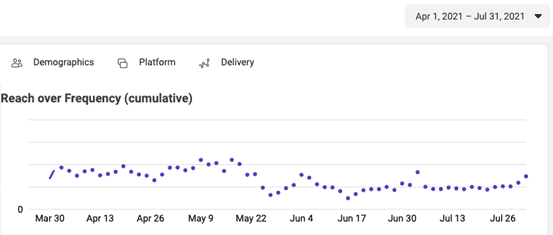
But, just because Facebook wasn’t tracking sales made after seven days didn’t mean customers weren’t purchasing products after that initial first week. Those purchases might not be tracked like they were before, but they were still happening — and the marketing strategy needed to incorporate that.
So, we encouraged Tactipup to take a step back. Instead of solely looking at Facebook results, they needed to look at the bottom line, too. Have website traffic patterns changed? What about revenue — Facebook-assisted and overall?
As long as our social campaigns continued to drive quality traffic to Tactipup’s website, our strategy was succeeding.
And that’s where the integrated aspect of our strategy comes in.
The Paid Search Puzzle Piece
While our team enjoyed the initial inheritance of well-performing social accounts, Tactipup’s Google Ads were another story.
Prior to our involvement, Tactipup’s team had run a few automated campaigns within the platform. But, without the right Google Analytics tracking, the data they needed to properly optimize and expand those campaigns was missing.
Our first step: Righting these tracking wrongs (it’s actually a common mistake among clients) to start gathering the historical data we needed to make improvements.
Then, it was about using our limited testing budget to prove our worth and make room for future account scaling.
1. Connecting the Multi-Channel Dots
From the very start, there were a few hints at just how interconnected Tactipup’s paid social and paid search efforts were.
Search queries like “Tactipup Instagram ad” or “Tactipup Facebook post” frequently popped up in Google Ads reports. When we looked at conversion paths in Google Analytics, customers often traveled back and forth between search and social channels in their buying journey.
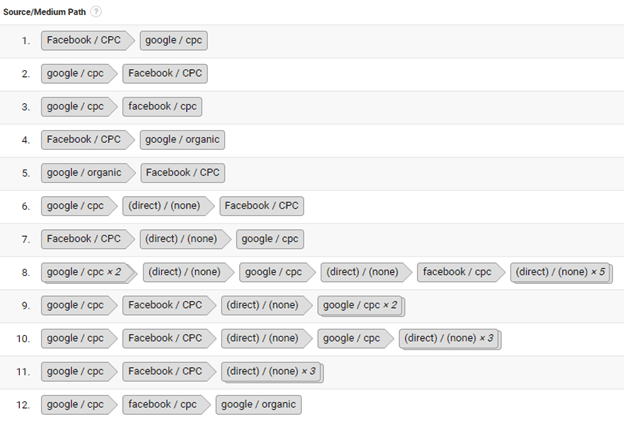
Whichever one they ended up buying from, those various touchpoints seemed crucial in retaining brand awareness and driving an eventual purchase.
It’s no wonder that branded search campaigns remain the majority of Tactipup’s paid search revenue. Through efficient social branding and advertising, they’d created a product that customers remember — and will search for on Google hours or even days after seeing that initial social ad.
Our job was finding that traffic, creating ads to best serve those customers, and pushing their conversions over the finish line.
And, with almost $300,000 generated on the search side and $273,000 on the social side in November 2021 alone, the approach clearly worked.
2. Launching Google Shopping Campaigns
Google Shopping is a non-negotiable for today’s online businesses. Unfortunately, Tactipup had no existing product feed when they brought our team onboard — which means they were missing out on key revenue opportunities, especially with all of the potential customers detailed above.
So, our team started slowly building out product listing ads (collars, leashes, harnesses, etc.), following our extensive product data feed optimization checklist and incorporating a mix of Smart and tiered Shopping campaigns.
The visual addition of these listings above the search engine page results meant more eyes saw Tactipup’s products, and, after the first test month, the results were near-immediate. This proved the opportunities of Google Shopping for the brand, and we continued to expand our product listings — eventually increasing revenue by 35% and transactions by 30% month over month.
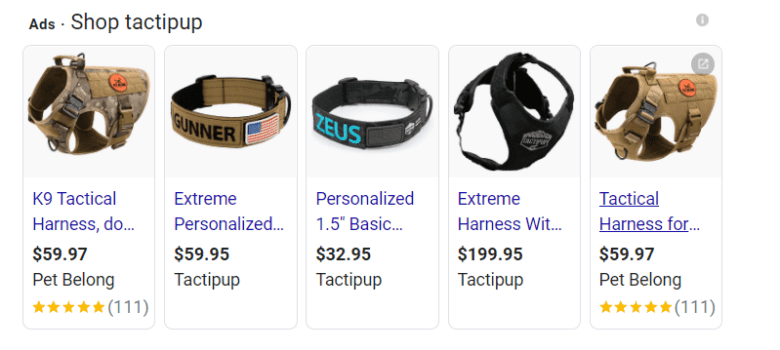
Almost a year (and many product listings) later, Google Shopping purchases consistently generated around 30% of Tactipup’s monthly paid search revenue.
Putting It Together: The Results
If Tactipup’s journey proves one thing, let it be this: Integrated marketing strategies drive the best results for eCommerce businesses.
It’s the reason why 26% of our clients contract our team for two or more services — and make up 42% of our actively managed revenue.
Tactipup is no exception. Their double-pronged marketing efforts — managed by one constantly communicating team — helped them hit their biggest sales month ever in November 2021.
In the months to follow, their campaigns continued to report recording-breaking numbers, including:
- 161% increase in Facebook revenue MOM
- 186% increase in PPC revenue MOM
- 312% increase in PPC-assisted conversions MOM
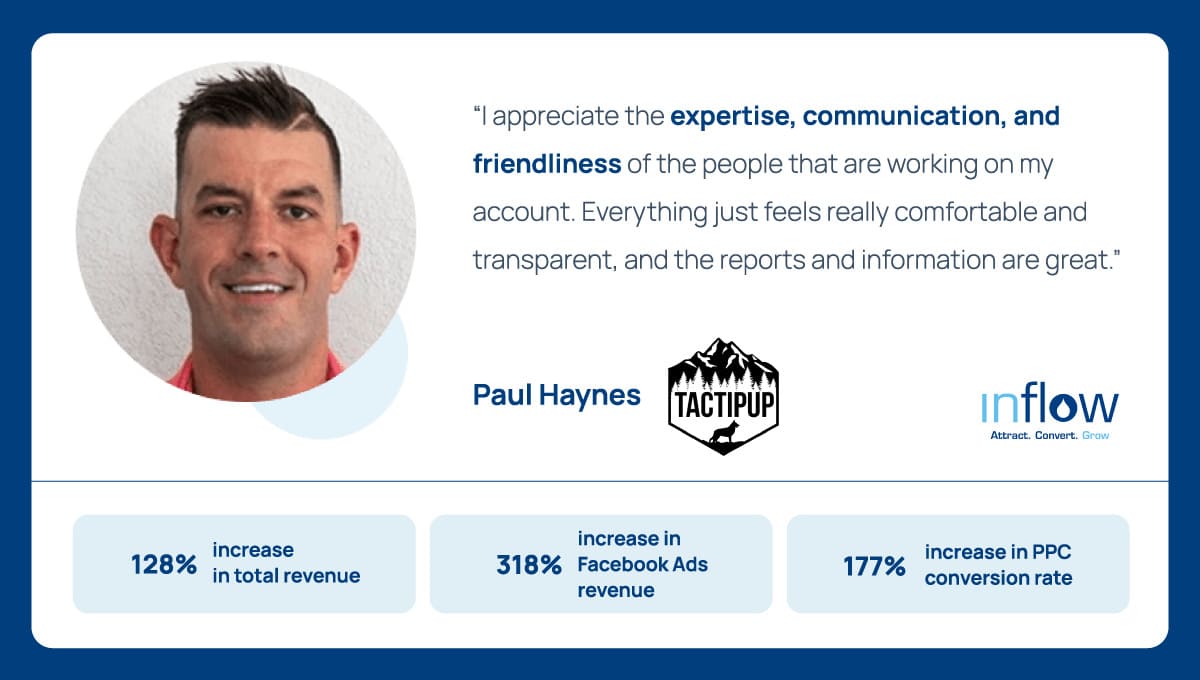
If you want to see similar results for your business, our team is always happy to help. Request a free proposal anytime, or check out our other case studies for more stories of our successful marketing strategies in action.










0 Comments